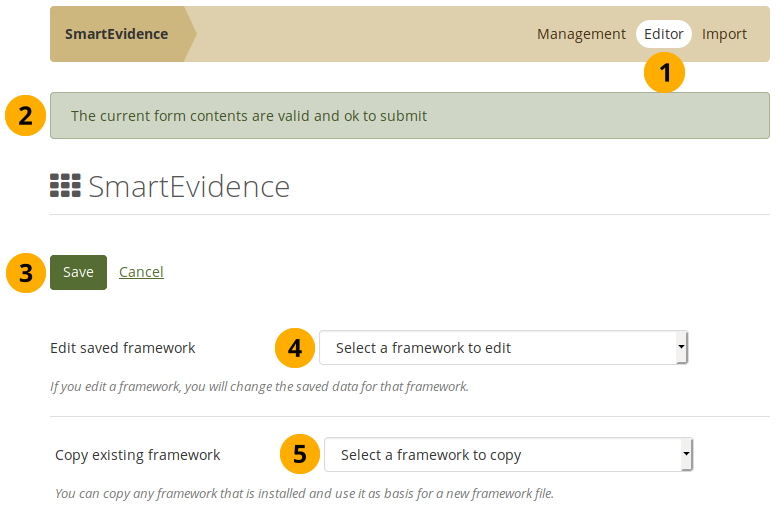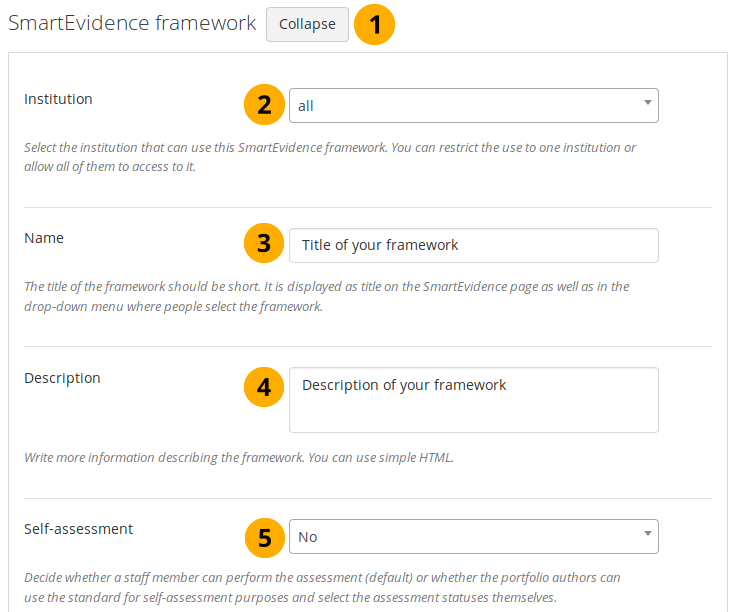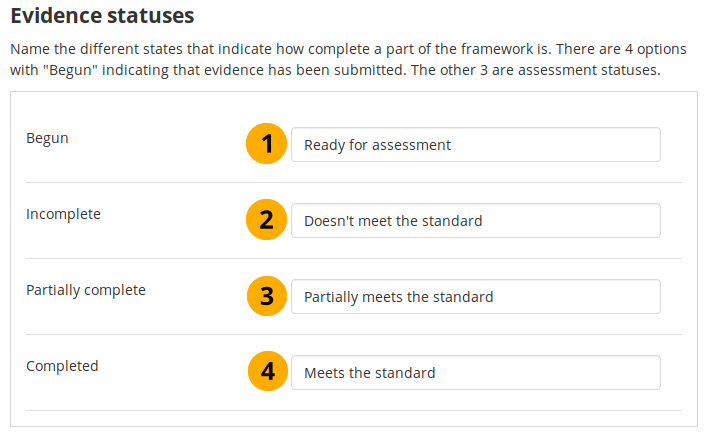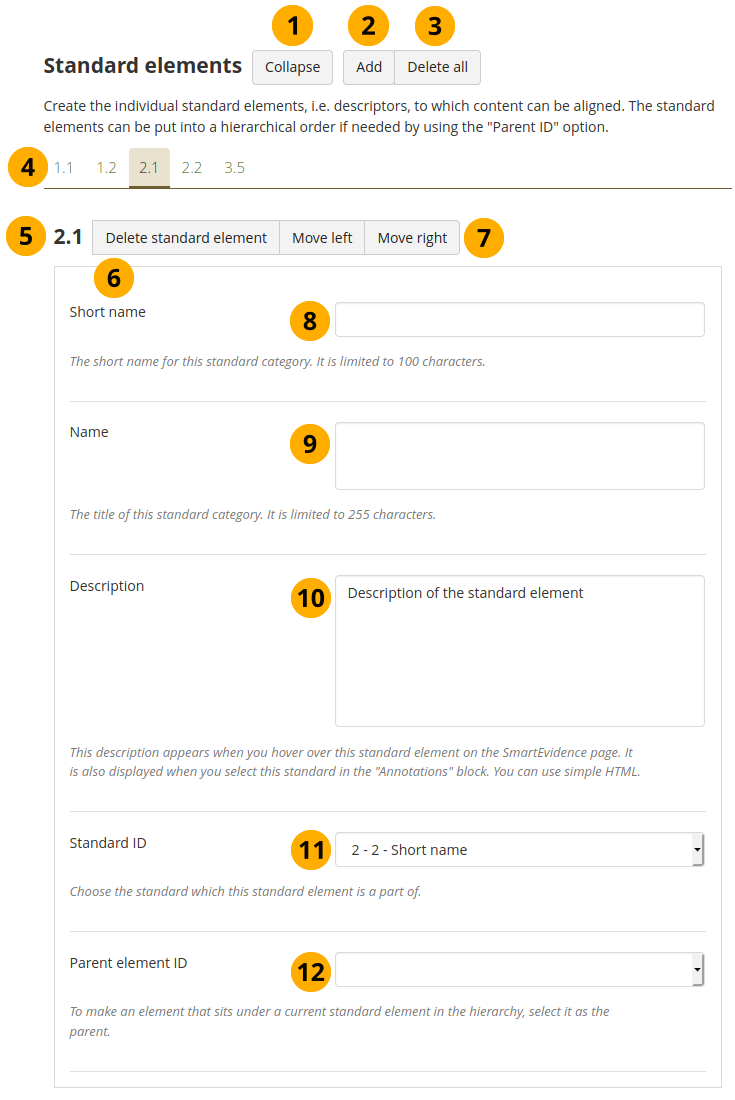11.9.3. SmartEvidence-Editor¶
Administrationsmenü → Erweiterungen → SmartEvidence → Editor
Sie können Ihre SmartEvidence-Framework-Datei direkt im Administrationsbereich in Mahara einrichten.
Diese Funktion ist experimentell und die erste Version der Editor-Implementierung. Wir möchten sie der Community bereits jetzt für Feedback und zukünftige Änderungen zur Verfügung stellen.
Es ist weiterhin möglich, SmartEvidence-Kompetenzrahmen-Dateien to hochzuladen, die Sie zuvor erstellt haben.
11.9.3.1. Edit, copy, or start from scratch¶

Erstellen Sie ein SmartEvidence-Framework mit dem Editor¶
Klicken Sie auf den Link Editor, um zu dem Bildschirm zu gelangen, auf dem Sie einen SmartEvidence-Framework erstellen können.
Ein JSON-Validator läuft im Hintergrund und informiert Sie über den aktuellen Zustand des Formulars. Wenn es Probleme gibt, werden Sie darauf aufmerksam gemacht.
Klicken Sie auf Speichern, um die vorgenommenen Änderungen zu übernehmen, oder klicken Sie auf Abbrechen.
Sie können ein bestehendes Framework bearbeiten und Änderungen vornehmen. Dies ist nur möglich, wenn das Framework inaktiv ist.
Sie können ein bestehendes Framework kopieren und Änderungen an der Kopie vornehmen. Das Framework, das Sie kopieren, kann aktiv oder inaktiv sein.
Sobald Sie ausgewählt haben, ob Sie ein Framework bearbeiten oder kopieren möchten, werden die ursprünglichen Daten automatisch im Formular angezeigt. Sie können auch ganz von vorne beginnen, ohne ein Framework, das bereits auf Mahara existiert, zu kopieren oder zu bearbeiten.
Siehe auch
Wenn Sie ein Framework bearbeiten wollen, das in einer .matrix-Datei vorhanden ist, können Sie das Framework importieren that framework, es auf ‚inaktiv‘ setzen und dann hier im Editor bearbeiten.
11.9.3.2. Grundlegende Informationen über das Framework¶

Grundlegende Informationen über das Framework¶
Click the Collapse button to hide all framework details. Click the Expand button to see all details again.
Institution: Select the institution for which the framework shall be available. If you select ‚all‘, every institution that has SmartEvidence enabled can work with this framework.
Name: Give your framework a title. Keep it short and unique as it is displayed as page title as well as in the drop-down menu on the collection’s edit screen when selecting a framework.
Description: You can enter a description that is displayed on the SmartEvidence page above the matrix in a collection. You can use HTML, e.g. links and font effects.
Self-assessment: Determine whether people can self-assess their competencies or whether the competencies can only be assessed by somebody else.
Click the Save button at the top or bottom of the page to keep your changes or click Cancel to abort the action.
Warnung
Be careful with the changes you make. There is no backup file to which you can go back to restore the original state of a framework.
11.9.3.3. Evidence statuses¶
Currently, there are four evidence statuses that can be used in an evidence map: begun, incomplete, partially complete, and completed. You can decide what words are used for these statuses in the framework that you set up. For example, this allows you to set up frameworks in different languages.

Framework statuses¶
Begun: This status indicates that the portfolio author has left an annotation and that the evidence is ready for assessment. The icon used in the matrix is a white circle with a blue outline .
Incomplete: This assessment status shows that the evidence does not meet the evidence criteria. It usually means major rework is required. The indicator symbol in the matrix is a white cross on red background .
Partially complete: This status is used when the evidence meets some of the criteria for which it was added. The icon used is a yellow half-moon .
Completed: The assessor uses this status when the evidence meets the criteria. The indicator icon is a white checkmark on green background .
Click the Save button at the top or bottom of the page to keep your changes or click Cancel to abort the action.
11.9.3.4. Standards¶
Create the categories in which your framework is divided. You can assign individual standard elements and sub-elements to these categories. You must have at least one standard category.

Set up the standards in a framework¶
Click the Collapse button to collapse this section. Click the Expand button to expand it again.
Click the Add button to create a new standard category. A new category is added to the end of the list.
All standards that are currently available are listed. The active one, i.e. the one for which details are displayed below, is highlighted. The standards are displayed in the matrix in the order in which they are listed here. You can move individual standards left or right when you selected them to change their order.
The title of the active standard category is displayed.
Click the Delete standard button to delete this particular standard.
Bemerkung
When you delete a standard and there are standard elements associated with it, they are going to be deleted as well.
Click the Move right button to reposition this standard. There is also the Move left button that is displayed when it is possible to move a standard higher.
Short name: Each standard needs a short name, e.g. a number or a summary of the full title. The short name is mandatory and a maximum of 100 characters long.
Name: Title of the standard. It is mandatory and a maximum of 255 characters long.
Description: The description is optional and is displayed when you hover over the name of the standard (touch-click on mobile).
Click the Save button at the top or bottom of the page to keep your changes or click Cancel to abort the action.
Bemerkung
You do not enter a ‚standard ID‘ as you do when creating the matrix file. Mahara keeps track of the position of the standard when you move it to the left or right. The database is updated accordingly.
11.9.3.5. Standard elements¶
Set up the individual standard elements, i.e. competencies to which content can be aligned. The standard elements can be put into a hierarchical order with the help of the ‚Parent ID‘.
Bemerkung
At the moment, standard elements are listed horizontally one after the other without breaks between individual standards.
The numbering is the internal Mahara numbering. If you wish your standard elements to be numbered, please put your numbers into the short name and / or name for the standard elements.

Set up the standards in a framework¶
Click the Collapse button to collapse this section. Click the Expand button to expand it again.
Click the Add button to create a new standard element. A new standard element is added to the end of the list.
Click the Delete all button to delete all standard elements you have set up.
All standard elements that are currently available are listed. The active one, i.e. the one for which details are displayed below, is highlighted. The standard elements are displayed in the matrix in the order in which they are listed here. You can move individual standard elements left or right when you selected them to change their order.
The title of the active standard element is displayed.
Click the Delete standard element button to delete this particular standard element.
Bemerkung
When you delete a standard element, and it is a parent of other standard elements, they are going to be deleted as well.
Click the Move right button to reposition this standard element. There is also the Move left button that is displayed when it is possible to move a standard element higher.
Short name: Each standard element needs a short name, e.g. a number or a summary of the full title. The short name is mandatory and a maximum of 100 characters long.
Name: Title of the standard element. It is mandatory and a maximum of 255 characters long.
Description: The description is optional and is displayed when you hover over the name of the standard element (touch-click on mobile).
Standard ID: Choose the standard to which you want to associate this standard element.
Bemerkung
The position of the standard element in the horizontal list of all elements determines where in the hierarchy it is positioned within a standard.
Parent ID: Select the standard element that is one level higher than the current standard element you are editing if the current element shall be a sub-element to another. You only see the standard elements for the standard that you selected in the Standard ID field.
Click the Save button at the top or bottom of the page to keep your changes or click Cancel to abort the action.